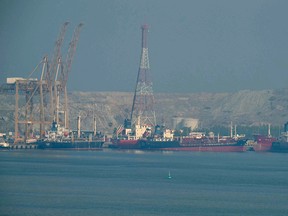
Article content
As Iran started firing missiles at a U.S. air base in Qatar on Monday, oil traders responded with striking speed — not by buying, but by selling.
THIS CONTENT IS RESERVED FOR SUBSCRIBERS ONLY
Subscribe now to read the latest news in your city and across Canada.
- Exclusive articles from Barbara Shecter, Joe O'Connor, Gabriel Friedman, and others.
- Daily content from Financial Times, the world's leading global business publication.
- Unlimited online access to read articles from Financial Post, National Post and 15 news sites across Canada with one account.
- National Post ePaper, an electronic replica of the print edition to view on any device, share and comment on.
- Daily puzzles, including the New York Times Crossword.
SUBSCRIBE TO UNLOCK MORE ARTICLES
Subscribe now to read the latest news in your city and across Canada.
- Exclusive articles from Barbara Shecter, Joe O'Connor, Gabriel Friedman and others.
- Daily content from Financial Times, the world's leading global business publication.
- Unlimited online access to read articles from Financial Post, National Post and 15 news sites across Canada with one account.
- National Post ePaper, an electronic replica of the print edition to view on any device, share and comment on.
- Daily puzzles, including the New York Times Crossword.
REGISTER / SIGN IN TO UNLOCK MORE ARTICLES
Create an account or sign in to continue with your reading experience.
- Access articles from across Canada with one account.
- Share your thoughts and join the conversation in the comments.
- Enjoy additional articles per month.
- Get email updates from your favourite authors.
THIS ARTICLE IS FREE TO READ REGISTER TO UNLOCK.
Create an account or sign in to continue with your reading experience.
- Access articles from across Canada with one account
- Share your thoughts and join the conversation in the comments
- Enjoy additional articles per month
- Get email updates from your favourite authors
Sign In or Create an Account
or
Article content
Within seven minutes of the first launch at about 5.30pm London time, Brent crude, the international benchmark, began to slide. It took only 20 minutes for the losses to accelerate to 3 per cent. By 7.30pm, the price had fallen 7.2 per cent to US$71.48, the sharpest daily drop in nearly three years.
Article content
Article content
Article content
The speed of the sell-off in a market that typically surges at any sign of geopolitical strife caught many by surprise. Even as civilians took cover and television channels broadcast images of missiles in the night sky, traders had already correctly concluded that the attacks would reduce, rather than heighten, tensions between the U.S., Israel and Iran.
Article content
“It is all orchestrated, we know the base is empty. I knew from June 18 that the base was empty,” said Jorge Montepeque, an oil analyst at Onyx Capital Group, in a text message just after the attack began on Monday. “We have watched this movie before.”
Article content
Since the outbreak of hostilities between Israel and Iran, traders said they had been glued to social media and open source intelligence to interpret developments. “Everyone is in a similar boat, we are all tracking Twitter feeds, Osint accounts and everything you can to make sense of it,” said one executive at a major oil trading firm.
Article content
Oil traders, for example, homed in on satellite images of Al Udeid air base in Qatar, which hosts 10,000 U.S. troops. They appeared to show that the U.S. removed planes from Al Udeid days before its air raid on Iran’s nuclear facilities this past weekend, and Tehran’s response to the attack on Monday.
Article content
Article content
That intelligence helped traders to draw two conclusions: the missile launches were largely symbolic, and the Islamic republic, having demonstrated a response to U.S. strikes on its nuclear facilities, was unlikely to further escalate by targeting the region’s most vulnerable asset — its oil infrastructure.
Article content
Read More
-

Oil spike fades as traders await Iran's response
-

Oil dips as Trump signals Iran strike decision
Advertisement embed-more-topic
Article content
Oil and gas have continued to flow unimpeded from the region throughout the fighting, with Iran increasing its exports, according to energy consultancy Rystad, because it was unable to refine as much crude domestically.
Article content
That reflected another feature of the oil market: traders are often good at keeping barrels flowing during the kind of turmoil that sends other industries into flight.
Article content
The market’s reaction on Monday echoed its behaviour a week earlier, when crude prices initially rose as much as 5.5 per cent following Israeli air strikes on Iranian gas plants and fuel depots, before the gains evaporated when signs emerged that Tehran was seeking peace talks.
Article content
Both episodes illustrate how, since the fighting began, traders have narrowed their focus to one overriding question: is Iran more or less likely to threaten oil tankers moving through the Strait of Hormuz, the 33km wide chokepoint that connects Gulf producers with global markets?

.jpg) 5 hours ago
1
5 hours ago
1


 English (US)
English (US)